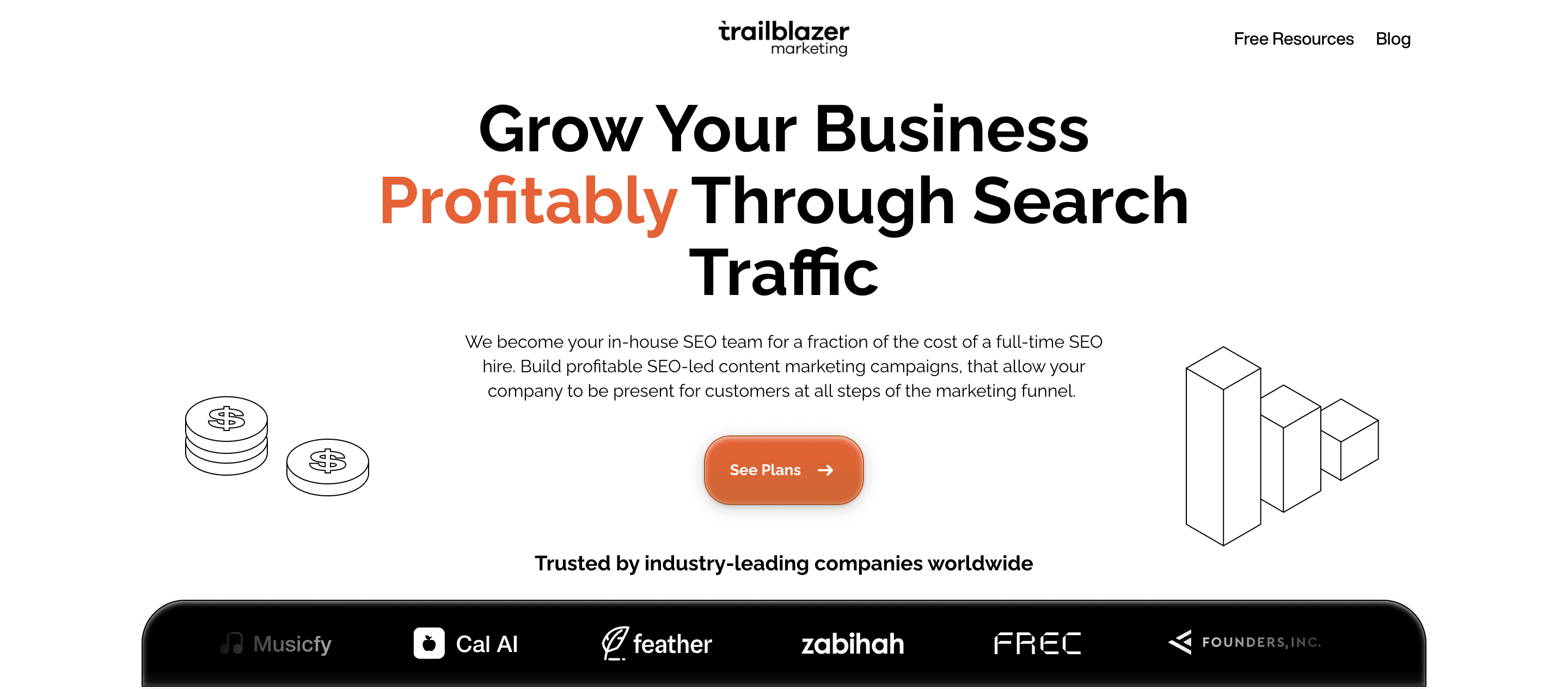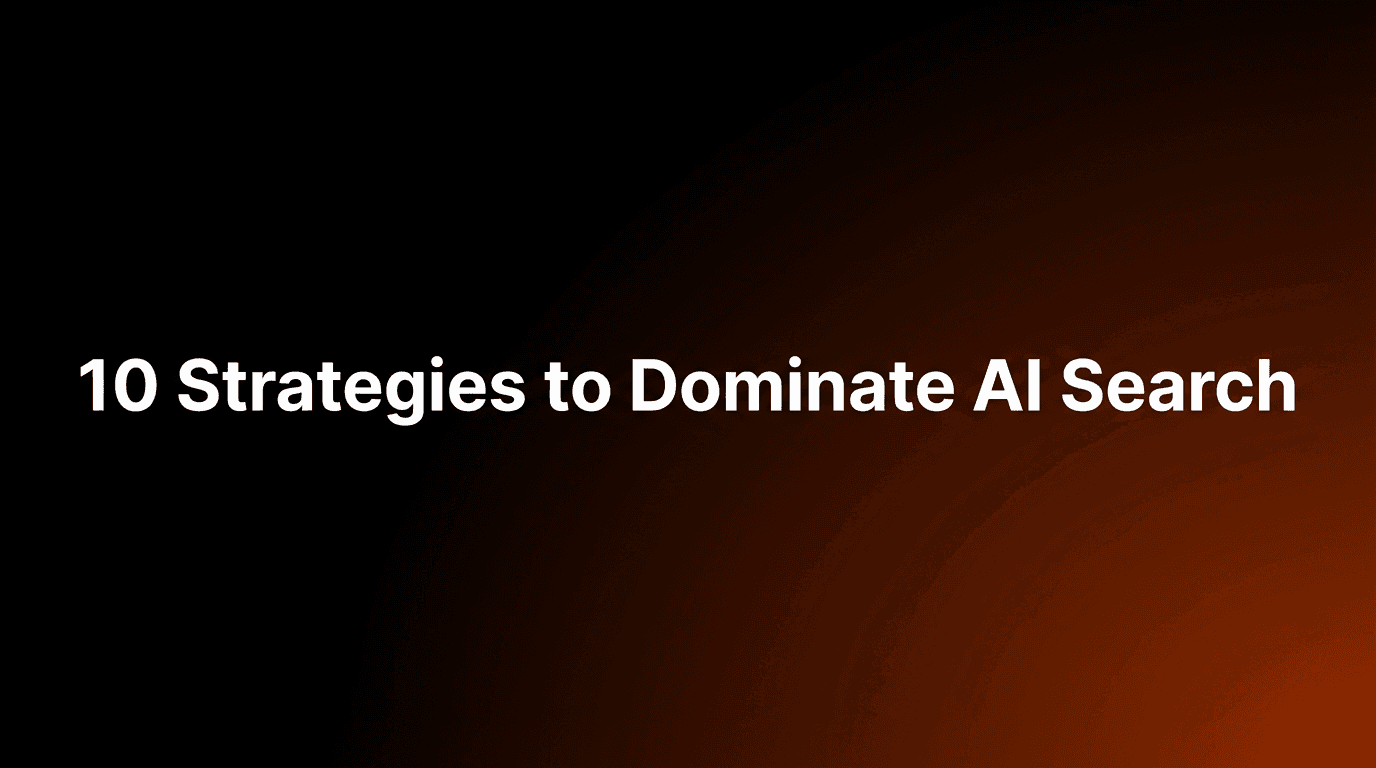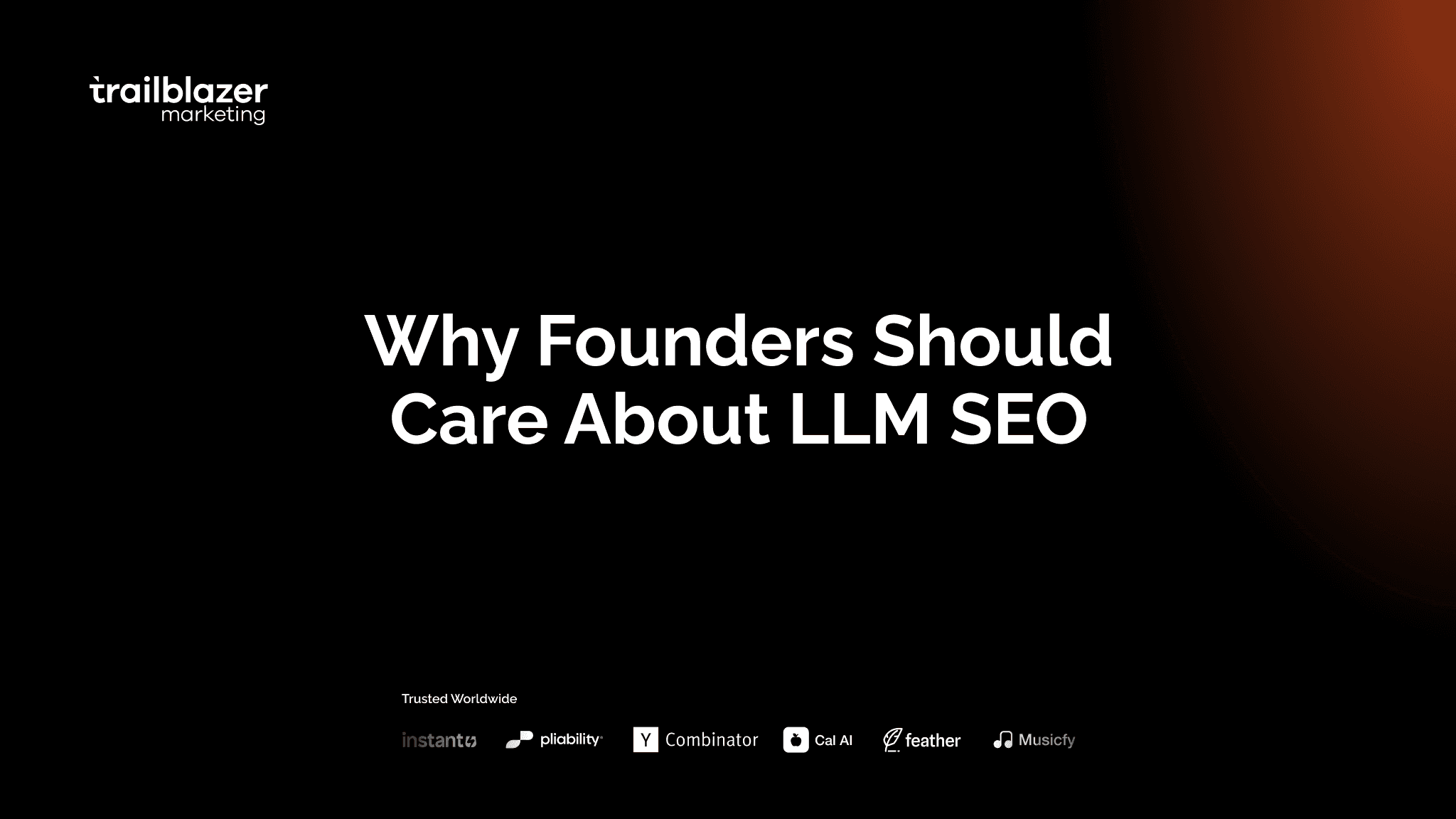10 Best AI Search Optimization Techniques to Dominate Search Results
Mar 31, 2025
Google's AI update demands new SEO. Learn AI Search Optimization strategies now to maintain rankings and visibility!
Artificial intelligence powers more than just chatbots and marketing automation. AI is also changing the way search engines operate. Google recently rolled out an update called "helpful content," which uses AI to score content and determine its value to users. With this shift, content created for AI, rather than humans, will lose rank and visibility on Google and other search engines. SEO strategies must change to meet the new demands of AI.
Enter, AI search optimization. AI optimization focuses on helping websites rank number 1 on Google and AI search results. The higher a site ranks, the more visible it will be to users looking for information on its niche. SEO strategies will change as AI continues to evolve. There's no time to waste. Start learning to optimize your site for AI today to maintain your visibility and readership amid the changes. This article will show you how to get started.
Table of Contents
Top 10 AI Search Optimization Strategies to Future-Proof Your SEO Strategy
Validate SEO for $300 - 3 Spots Available per Month | Reserve Your Spot Today
What Is AI Search Optimization and Its Importance

Level Up Your Traffic with AI Search Optimization
AI Search Optimization enhances search engine results by leveraging:
AI-powered algorithms
Machine learning
It improves:
Search relevance
User experience
Content visibility
Mastering AI SEO
This comprehensive guide will help you navigate the new landscape of AI search optimization and fine-tune your SEO strategy for next-generation content ranking. Unlike traditional SEO, which targets search engine algorithms, AISEO ensures that AI engines can provide accurate, context-aware, high-quality responses or recommendations based on your content.
AI's Importance Now
Users interacting with AI tools like ChatGPT or Alexa expect precise and relevant answers. AIEO ensures that your website or business content is among these AI tools’ top sources. If you want your website to be visible on every search engine, your content will need AI search optimization. If you think this shift came suddenly, Google has slowly but surely kept infiltrating artificial intelligence into its algorithm since 2015.
AI Search Evolution
It all started with RankBrain (which is still very active). This machine learning-based search engine algorithm could recognize meaningful and useful content even if it didn’t use the exact phrase or keyword. Then BERT came (2019), MUM (2021), and the most advanced and the latest one, Google Bard (now Gemini), and Generative AI search (2023). Besides the classic search engines gradually introducing AI, 2024 brought a huge change. LLM AI tools we all use regularly have expanded their features and presented AI search engines. Your customers started using them.
New SEO Rules
To keep up the peace, traditional search engines also pushed more intuitive search results using more sophisticated AI algorithms, which together changed the way an effective AI search SEO strategy looks today compared to optimization just a few years back. This new challenge for all marketers is learning new SEO rules from scratch because you want to appear in the search results.
What is AI Search Optimization?
AI search optimization is another word for adjusting content so that it’s easy for artificial intelligence to:
Read
Process
Surface AI-powered search engine results
The content must have a natural flow, sound human, and be knowledgeable and useful for the reader.
AI Values Relevance
Relevance will always be in demand. If your content covers trending topics, provides expert insights, and includes real-life examples, it will stay aligned with:
Future algorithm updates
AI-driven SEO changes
RIP keyword stuffing. No one (including generative AI engines) likes it. And since artificial intelligence is all-present, you must approach your SEO strategy and content creation differently if you want your business to appear in the results.
AI Search Results
Search results look different than previously with:
Google’s AI overviews
ChatGPT search
Gemini
Perplexity
Other AI systems
Optimize for AI
These make things easier for users to find what they’re looking for, and you’re probably wondering how to get listed in AI platform responses. The good news is that you can:
Optimize any content to the new rules
Generate traffic
AI Platform Differences
The bad news is that you’ll probably need a specific optimization for each AI search platform. That’s why you’ve probably heard of terms such as:
LLM Optimization (Large Language Model Optimization): Optimizing input/output for tools like classic ChatGPT or Gemini and other language-based AI systems with no real-time access to the information.
AI SEO (Search Engine Optimization for AI-powered search): Adapting traditional SEO strategies to align with AI-driven search engines (e.g., Google’s RankBrain or MUM).
GEO (Generative Engine Optimization): Optimizing for AI-generated experiences rather than traditional search results.
Is it Different from Generative Engine Optimization (GEO)?
Yes and no. The main difference here is that with AI search engine optimization, you’re optimizing your content to rank higher on search engine results pages on Bing’s or Google’s search, whether in the top results, while with GEO, you aim to create content that will be included in the:
Google’s AI Overviews and Bing’s Summaries: Those AI-generated summaries at the top of search results.
AI-powered chatbots: Those like the Gemini model customized for Google Search, Perplexity, and ChatGPT Browsing have gained popularity.
Voice assistants: Like Google Assistant or Alexa.
AI Search Convergence
Generative search engines can (but don’t have to) provide the sources (links), while traditional search engines give the links. Even Google searches use AI models to refine search results, and generative search engines use Google’s (or Bing’s) results. That’s why there’s no clear line between AI SEO and GEO. Your content should be optimized according to new rules if you want to appear in the results in all AI-powered search engines.
LLM Models and Their Algorithms
The principle of work is slightly different regarding LLM models, which didn’t have the browsing option, like:
GPT
Gemini 1.0
Instead of retrieving and ranking web pages, they generate responses using pre-trained models that predict the next best word based on the context of your query. Both GPT (by OpenAI) and Gemini 1.0 (by Google) are LLMs (Large Language Models) that work based on three key steps:
1. Understanding the Query Natural Language Processing (NLP)
When you type something, the model processes your words using NLP. To understand what you’re asking, it breaks down:
Sentence structure
Intent
Meaning
2. Generating a Response (Probability & Prediction)
Instead of searching the web, GPT and Gemini use a huge dataset of text they were trained on:
Books
Srticles
Wikipedia
These models don’t know things like a search engine does. They predict the most statistically likely next word based on your query. If you ask, “What is the capital of France?”, the model doesn’t look it up. It generates “Paris” because that’s the most common answer in its training data.
3. Fine-Tuning & Reinforcement (Human Feedback)
AI models like GPT-4 and Gemini are fine-tuned using human feedback to ensure helpful and safe responses. They use RLHF (Reinforcement Learning from Human Feedback), where AI learns from human-rated answers to improve responses over time.
Advanced LLM Models with Browsing Features
ChatGPT-4o (with browsing enabled), Gemini 2.0 (launched in December 2024), and Perplexity AI are a mix of a language model (LLM) and a search engine. They can both generate responses and retrieve real-time information from the web. There’s a difference between them. Unlike standard GPT-4, ChatGPT-4o with browsing can access the internet in real time when needed. The same goes for Gemini 2.0, which is very interesting. It understands the query using LLM-based NLP but then decides whether it’s necessary to browse. Then, the response is generated using LLM + Search-Verified Data.
AI Data Sources
Take these 2 queries:
1. Who won the presidential elections in the US in November 2024? where GPT-4o automatically browsed and provided sources.
2. Who was the first president of the U.S.? where GPT-4o decided to use its knowledge base.
The Impact of AI Search on Traditional SEO
Whether we like it or not, AI has changed the search landscape and has made a huge impact on traditional SEO, because it used to rely on:
Keyword stuffing
Exact keyword matching
Simpler ranking rules
Results based on backlinks
Separate text
Video
Image search
No direct answer
And how would the old SEO fit into semantic and contextual understanding, machine-learning-based ranking, results based not only on the internet, but also user behavior, multimodal AI search including:
Text, voice, image combined
Conversational approach
AI overviews
Summaries
Rethink SEO Approach
The answer is that it doesn’t fit. It needs adjustment. SEOs must change their optimization strategies and lose some strict rules and keyword race to appear in the AI search results. The content has to appeal more to what people want to see. SEOs must:
Take two steps back
Consider the intent, not the result
Original Content Matters
Writers must provide their first-hand experience and do the original research. Rephrasing and redoing will no longer do the trick.
Expert AI SEO

Trailblazer Marketing serves as your dedicated SEO team, driving profitable growth through strategic content that ranks prominently in both Google and Bing, as well as AI search platforms like:
ChatGPT
Claude
Perplexity
Scientific SEO Results
Our scientific approach has delivered extraordinary results across industries. It helps companies rank number 1 in Google and AI search, including a B2C SaaS client with a 3,518% increase in non-branded traffic within 21 days. Ultimately, this client generated 2.1M organic clicks and over $700,000 in first-year revenue—far exceeding their $300,000 ARR goal.
Proven Methodology and Remarkable Growth
Similar success stories include a B2B SaaS client achieving 9,644% traffic growth within 10 months and a mobile app seeing a 65 %+ increase in downloads within 50 days. Our comprehensive methodology sets us apart:
Long-term planning
Product-led keyword research
Competitive analysis
Strategic backlink building
High-velocity content production
Test Drive SEO: Affordable 30-Day Results
Most SEO agencies require thousands per month upfront. Still, our $300 Validate Program lets you test our process with 10 SEO-optimized articles and see actual results within 30 days before committing to a more significant investment. We only have 3 spots available monthly; reserve yours today!
Related Reading
Top 10 AI Search Optimization Strategies to Future-Proof Your SEO Strategy

1. The Easy Way: Go After Informational, Long-Tail Keywords
Long-tail keywords have always been part of smart SEO strategies, but they matter even more for AI search visibility. Instead of focusing on exact-match phrases, AI connects related terms through:
Semantic search
Natural language understanding
Use long-tail keywords to match user intent rather than just inserting static phrases. Optimize for voice search queries. AI prefers natural-sounding language, so use a conversational tone of voice. Focus on semantic variations instead of exact matches (running shoes for joint support instead of repeating best running shoes for knee pain). Structure content with schema markup to help AI recognize key takeaways.
2. The Smart Way: Use Structured & Concise Information
AI search engines prioritize clear, well-structured content that can be easily scanned and summarized for AI-generated answers.
Keep paragraphs short, 2-3 sentences max, for better readability.
Use bullet points and numbered lists for quick AI extraction.
Format content with H2/H3 subheadings to match AI-generated responses.
Optimize for featured snippets and AI Overviews by answering questions clearly and concisely.
3. The Building-Blocks Way: Leverage Trust and Authority for AI Search
Artificial intelligence search engine optimization prioritizes content from credible sources over generic, AI-generated text. The key to ranking in AI search results is E-E-A-T or:
Experience
Expertise
Authoritativeness,
Trustworthiness
Show real expertise, including:
Author bios
Credentials
Case studies
Build AI Trust
Build trust with transparency:
Cite sources
Use real-world insights
Provide industry-backed data
It’s all about high-quality content. Focus on data-driven content:
Surveys
Original research
Expert opinions carry more weight in AI rankings.
4. The Unexpected Way: Increase Site Authority with Brand Mentions
AI search engines no longer rely solely on backlinks. They scan the web for brand mentions, even without links. The more your brand is referenced online, with positive reviews and mentions, the more authority and credibility it gains in artificial intelligence search engine rankings. One of the crucial things for ranking on ChatGPT. Monitor brand mentions using social listening tools, like Mentionlytics, to track how often and where your brand appears. Engage in industry conversations. Participate in relevant discussions on:
Social media
Forums
Blogs
Manage Brand Mentions
Soften negative reviews by providing answers and turning bad reviews into (at least) neutral sentiment.
5. Optimize for Conversational Queries
Structure Content Around Questions and Answers. Keyword stuffing has been outdated for a while. As with traditional SEO, don't do it. Today, it's all about providing clear, direct answers to specific questions. Consider structuring your content as a Q&A session:
Start with a common question in your niche
Provide a concise answer immediately after
Follow up with more detailed explanations
Mirror Perplexity Style
This format mirrors how:
Perplexity presents information, making it more likely for your content to be cited as a source
Example of articles and how they're structured to answer the question at the very beginning of the article
Embrace Natural Language and Conversational Tone
When crafting your content, imagine you're explaining the topic to a friend over coffee. This approach helps in several ways:
It makes your content more engaging and relatable
It aligns with how people naturally phrase their queries
It improves readability, which is crucial for both users and AI systems
Perplexity is designed to understand and respond to natural language queries. You speak the same language as the AI and its users by writing in a conversational tone.
Anticipate and Address Follow-up Questions
One of Perplexity's unique features is its ability to generate follow-up questions. To stay ahead of the curve:
Brainstorm potential follow-up questions related to your main topic
Incorporate these questions and their answers within your content
Use subheadings or FAQ sections to address these questions directly
By anticipating and addressing follow-up queries, you're providing more comprehensive content and increasing the likelihood of your article being cited for multiple related searches.
6. Harnessing Perplexity's Follow-Up Questions for Content Creation
Research Common Follow-Up Questions
Start by using Perplexity to explore your topic thoroughly
Enter a broad query related to your subject matter
Note all the follow-up questions
Perplexity generates
Click on relevant follow-up questions to dive deeper
Repeat this process, branching out into various subtopics
This method lets you map out the entire landscape of user questions about your topic.
Create Comprehensive FAQ Sections
Once you've gathered a robust list of follow-up questions:
Organize the questions into logical categories
Prioritize questions based on relevance and frequency
Use the most pertinent questions as the foundation for your FAQ section
Craft detailed, accurate answers to each question
By basing your FAQ on Perplexity's follow-up questions, you're addressing the exact queries your audience is likely to have. This approach significantly enhances the relevance and usefulness of your content.
Address Questions Comprehensively in Your Content
Beyond creating a dedicated FAQ section, use these insights to enrich your main content:
Incorporate answers to key follow-up questions throughout your article
Use the questions as subheadings to structure your content logically
Anticipate and address potential reader questions before they arise
Provide in-depth explanations for complex topics highlighted by follow-up questions
This strategy ensures your content is thorough and leaves no stone unturned, satisfying casual readers and those seeking detailed information.
7. Structuring Content for Easy Extraction
This approach makes your content more user-friendly and increases the likelihood of Perplexity citing your work.
Provide Clear, Concise Answers Upfront
The inverted pyramid style, traditionally used in journalism, is highly effective for Perplexity optimization:
Start each section with a direct answer to the main question
Follow with supporting details and explanations
End with background information or related topics
This structure allows Perplexity to identify and extract the core information quickly.
Say, the boiling point of water is 100°C (212°F) at sea level. This temperature can vary based on atmospheric pressure, with higher altitudes resulting in lower boiling points. The relationship between boiling point and pressure is described by the Clausius-Clapeyron equation.
Prioritize Key Info
By providing the key information upfront, you increase the chances of your content being featured in Perplexity's quick answers or summaries.
Leverage Bullet Points and Numbered Lists
Bullet points and numbered lists are powerful tools for organizing information:
They break up dense text, making content more scannable
They present information in a structured, easy-to-digest format
They help Perplexity identify and extract key points quickly
Effective List Use
When using lists:
Keep each point concise and focused
Use parallel structure for consistency
Start with the most important information
Limit lists to 5-7 items for optimal readability
While lists are useful, they shouldn't dominate your content. Use them strategically to highlight key points or steps in a process.
Include Brief Summaries or Key Takeaways
Summaries and key takeaways serve multiple purposes:
They reinforce the main points for readers
They provide a quick reference for those skimming the content
They offer Perplexity a concise, extractable summary of your article
Consider including:
A brief summary at the beginning of long articles
Key takeaways at the end of each major section
A comprehensive summary or conclusion at the end of the article
Concise Summaries
When crafting these summaries:
Focus on the most important information
Use clear, straightforward language
Avoid introducing new information
Keep them concise, typically 2-3 sentences or 30-50 words
Here's An Example Of A Section Summary
Structuring content for easy extraction involves providing clear answers upfront, judiciously using bullet points and numbered lists, and including summaries. This approach improves user readability and increases the likelihood of your content being cited by AI-powered search engines like Perplexity.
8. Optimize for Industry-Specific Platforms
To maximize your content's visibility on Perplexity AI, it's crucial to establish a strong presence on platforms that are frequently cited within your specific industry. Perplexity often draws information from authoritative, industry-specific sources to comprehensively answer user queries. By strategically positioning your content on these platforms, you can increase the likelihood of being cited by Perplexity and reaching a wider audience.
Identify Key Platforms
Research which platforms Perplexity commonly references when answering questions related to your industry. Some examples include:
TripAdvisor and Booking.com for travel and hospitality
Yelp for restaurants and local businesses
LinkedIn for professional services and B2B content
GitHub for software development and tech-related topics
Optimize Your Presence
Once you've identified the relevant platforms, focus on optimizing your presence:
Create comprehensive profiles or listings
Regularly update your information
Encourage customer reviews and ratings
Publish high-quality, industry-specific content
9. Leverage User-Generated Content
Many industry-specific platforms thrive on user-generated content. Encourage your customers or clients to share their experiences. Google values this information, so it likely affects how Perplexity compiles information.
10. Emphasis on Data Visualizations
Perplexity AI appears to prefer diagrams, charts, and graphs for several reasons:
Data Comprehension: Visual representations often make complex data more accessible and easier to understand at a glance.
Trend Analysis: Charts and graphs effectively convey information for queries involving changes over time or comparing entities.
Scientific and Academic Content: Many academic and scientific sources use diagrams and charts to illustrate findings, which Perplexity may prioritize for their credibility and information density.
Integration with Text Responses
Perplexity's approach to integrating visual elements with text responses enhances the overall user experience:
Complementary Information: Charts and diagrams are often presented alongside text explanations, providing additional resources to user queries.
Visual Anchoring: Perplexity helps users connect textual information with the visual data by referencing specific visual elements in text responses.
Diverse Visual Content
While Perplexity does emphasize data visualizations, it also includes other types of images when relevant:
Contextual Imagery: For queries that benefit from visual context beyond data, Perplexity will include relevant photographs or illustrations.
Platform-Specific Results: When searching across specific platforms like YouTube or Reddit, perplexity may include thumbnails or other platform-specific visual elements.
Related Reading
Validate SEO for $300 - 3 Spots Available per Month | Reserve Your Spot Today

Most SEO agencies only focus on short-term gains. They want to get your business traffic as quickly as possible to prove their value and get paid. So, they crank out a bunch of content targeting low-hanging fruit keywords and don't care what happens when they get bored and move on. This approach might help you attract a few extra visitors, but it won't help you build a sustainable SEO strategy to get you where you want to go. At Trailblazer Marketing, we take the opposite approach. We focus on your long-term goals and create a custom plan to help you achieve them.
Build Authority Now
Our detailed, scientific approach to SEO will help you build authority in your niche and attract the right kind of traffic that converts to loyal customers.
Product-Led Keyword Research
Every SEO strategy is built on keyword research. Not all keyword research is created equal. Most agencies focus on finding keywords with the highest search volume, which doesn't necessarily help your business. These keywords might get you traffic, but won't help your target audience find your product. At Trailblazer Marketing, we take a different approach. We conduct product-led keyword research to help you find and rank for the terms that will bring your business more customers. Our method involves first developing a clear understanding of your product and its features.
Targeted Keyword Strategy
We identify the keywords that can help your target audience find your product quickly. Our approach enables you to attract qualified traffic ready to convert to paying customers.
Competitive Analysis
SEO is all about competition. No matter what industry you're in, other businesses are bound to target the keywords you want to rank for. To succeed at SEO, you not only need to understand your competition. You also need to develop a strategy to outperform them. At Trailblazer Marketing, we conduct detailed competitive analyses to identify your top rivals and uncover their strengths and weaknesses. We'll help you understand how to leverage their weaknesses to rank higher than them on:
Google
Bing
AI search platforms
Strategic Backlink Building
SEO is also all about authority. The higher your website's authority, the more likely you rank well on search engine results pages. One of the best ways to increase your website's authority is through backlink building. Backlinks are links from other websites to yours. When search engine crawlers see these links, they view them as "votes of confidence" for your website. The more quality backlinks you have, the more likely you rank well on SERPs. At Trailblazer Marketing, we take a strategic approach to backlink building. We'll help you identify relevant industry-related websites with good authority and develop a plan to earn links from them.
High-Velocity Content Production
SEO is all about creating content. The more quality content you have on your website, the better. At Trailblazer Marketing, we help you take a scientific approach to SEO content creation to help you get where you want to go quickly. Our strategies will help you increase organic traffic, attracting more visitors and converting them to loyal customers:
We help you develop a long-term plan to create content that targets your business goals.
We identify your audience and create content that speaks directly to them.
We produce the content at an accelerated rate so you can reach your SEO goals as quickly as possible.
Related Reading
Dec 11, 2025
The 2025 LLM SEO Playbook: 10 Proven Strategies to Dominate AI Search
This playbook synthesizes the most critical learnings for 2025, moving beyond traditional SEO to a more holistic framework.
Jul 16, 2025
Why Founders Should Care About LLM SEO (Before Everyone Else Does)
LLM SEO is like Google SEO in the early 2000s. This is the biggest organic growth opportunity at the moment. First movers will lead organic growth for the coming decades.
Apr 2, 2025
Rank #1 on Generative AI Search Engine with these Optimization Strategies
AI-driven generative AI SEO. Learn how to create content and GEO strategies for enhanced visibility & personalized results.

Free Resources
Used to help top companies:









